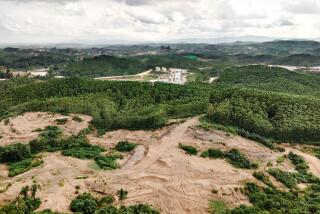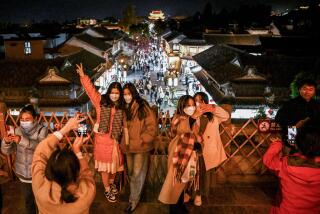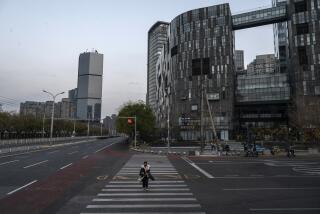Megacity Madness Grows in China, Asia
- Share via
SHENYANG, China — Smokestacks and factory compounds stretch from downtown to the smoggy horizon. Canals fouled by sewage encircle the city.
Shenyang strains to cope with overcrowding, pollution and water shortages from rapid growth. And it’s getting bigger.
Twenty years ago, this industrial city had a population of less than 3 million. Today, it’s 6.8 million. By 2025, Shenyang’s residents are expected to number more than 10 million.
It’s a pattern being repeated throughout Asia. By 2025, at least 20 Asian cities will balloon into megacities of more than 10 million people, the Asian Development Bank predicts.
Worldwide, urban population is expected to double from 2.4 billion in 1995 to 5 billion in 2025. About 173 million of those people will squeeze into the 20 Asian megacities alone. Bombay, India, with 33.2 million people, will become the world’s biggest city, displacing Tokyo, which will have 28.7 million residents.
The cities expected to grow the fastest--Jakarta, Indonesia; Dhaka, Bangladesh; Karachi, Pakistan--are some of the worst equipped to provide roads, sewers, housing, clean water and other essential infrastructure.
Wretched living conditions and competition for jobs can make cities powder kegs of potential unrest. Extreme disparities in wealth--a fact of life in most Asian cities--helped spark election riots this spring in Jakarta, Indonesia’s capital.
Living in the industrial heart of northeastern China, Shenyang’s 6.8 million people are the heirs of four decades of intense, state-owned and -guided industrialization.
Well beyond the Great Wall, 530 miles northeast of Beijing, Shenyang--once known as Mukden--historically was a sleepy trading center frequented by nomadic herders.
During the 17th century it briefly rose to prominence as the capital of China’s Qing Dynasty.
In September 1931, the Japanese attacked Mukden and then annexed all of northeastern China. Intending to make the region they called Manchuria an industrial and raw resources base for their own crowded islands, they quickly built railways, ports and factories.
The city’s Japanese legacy is apparent in grimy but ornate two-story shops and villas that are slowly giving way to new office towers and shopping malls.
Now China’s seventh-largest city, Shenyang lacks the tin and cardboard squatter slums of Jakarta or Yangon, Myanmar, partly because of the government’s large role in its growth and its bitter winter weather. But it still has many problems, which are aggravated by its faltering state-run economy.
A statue of Communist revolutionary leader Mao Tse-tung stands in the city’s center, his hand stretched benevolently over a sculpture of workers, peasants and soldiers toiling at his feet.
“Long live the proletariat,” declares the faded slogan on a brick building that has been converted into an appliance-repair shop.
Shenyang’s proletariat has seen better days.
The city remains one of China’s most important industrial hubs, specializing in machinery, electrical power, chemicals, textiles, food processing and metallurgy.
But more than half of Shenyang’s mainly state-run factories are operating at a loss and at least 1,000 have closed or are running at half-capacity. Unemployment is estimated at 20%, perhaps higher. Laid-off workers can be seen in some districts begging to work for food.
Pollution is not as bad as in Jakarta, where children float in inner tubes along polluted rivers collecting trash for recycling. But the canals ringing Shenyang reek from raw sewage and industrial waste. After local legislators complained this spring, the provincial government promised to spend $1.3 billion to build 21 water-treatment plants.
A forest of factory chimneys crowds right up to the handful of glossy hotels that tower over the city’s tiny but growing financial and commercial center. Squat, five- and six-story factories are ringed by rundown workers’ apartments largely bereft of trees or other vegetation.
The city has set up huge tracts of street markets--thousands of stalls selling clothes, hats, shoes, toys, whatever might find a buyer, to provide jobs for some of its 230,000 laid-off workers.
“Most find they are richer now than on their factory salaries,” says Zhang Limin, assistant director of the special economic zone’s Economic and Trade Bureau.
But during a reporter’s recent visit, business appeared far from brisk. Many salesmen and women--mostly laid-off factory workers--lay sleeping in their stalls or sat staring into space.
Zhang says the city hopes to attract outside investment to help renovate bankrupt and obsolete factories.
The city also is seeking outside help for its environmental problems. It has joined a project sponsored by the U.N. Development Program that will draw up plans for dealing with its severe air pollution and waste problems.
Shenyang’s struggle to balance rapid economic growth and quality of life is typical of cities nationwide.
In 1949, only one in 10 Chinese lived in cities. Now almost one-third do--about 400 million people. The figure may be as high as 520 million if the huge population of job-seeking rural migrants crowding into the cities is counted.
Until quite recently, the government used a strictly enforced household registration system to discourage migration into the cities.
“There was almost no investment in infrastructure. The government did not even want to talk about urban development,” says Elisabetta Capannelli, a researcher at the Asian Development Bank.
“Now, the market is taking over. Cities are growing incredibly fast. The government is just beginning to invest in the infrastructure that is needed.”
Rapid urbanization isn’t all bad. The Asian Development Bank notes that cities are centers of economic activity and growth. Urban incomes are higher than rural wages, and living standards generally better, especially in developing countries like China.
Making such huge cities livable is a challenge. In Asia alone, about $20 billion must be spent each year on the infrastructure needed to keep cities running: roads, ports, dams, housing, sewers and the like, the bank says.
Shortages of clean water, safe housing and sanitation cause the deaths daily of about 50,000 people living in megacities worldwide.
Of the 138 large rivers running through China’s cities, only 32 meet national health standards. Noise levels exceed government limits in about two-thirds of all urban districts, according to a recent government report.
Shenyang is banking on its industrial heritage, hoping that eventually it will benefit from the wealth and foreign investment that has helped other Chinese cities, such as Shanghai and Beijing.
Perhaps then it will regain some of its past glory. For now, its Imperial Palace, a miniature version of Beijing’s majestic Forbidden City, sits forlornly at the city center, a weedy, gilt and vermilion island of tranquillity amid the choking smog and honking horns of the traffic outside.
More to Read
Sign up for Essential California
The most important California stories and recommendations in your inbox every morning.
You may occasionally receive promotional content from the Los Angeles Times.










